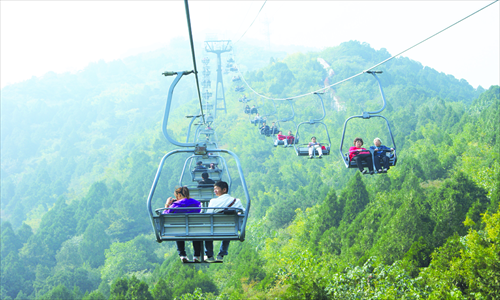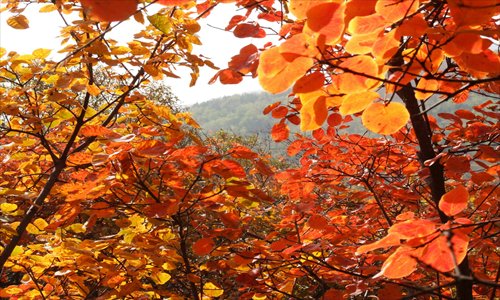Foliage frenzy


Beijing is a city of seasonal split personalities, where winter can be unforgivably cold and summer oppressively hot. However, autumn sees the Chinese capital turn on its charm offensive with comfortable temperatures coupling the vibrant dark red-purple hues of leaves. There are few places better than the Fragrant Hills on the western outskirts of Beijing to witness this transformation, where the park's annual Red Leaves Festival began on October 12.
This year's festival spans 31 days, the longest in the event's 24-year history, with an estimated 1.5 million visitors expected to hit the mountain during this period.
Mountain steeped in history
The Fragrant Hills are more than a foliage fan's paradise, with the mountain also tempting history buffs and those with an interest in cultural relics. Like its nearby tourist attraction counterparts, Yiheyuan (the Summer Palace) and Yuanmingyuan (the Old Summer Palace), the Fragrant Hills has its share of tales steeped in historical hardship.
With origins tracing back to 1186 during the Jin Dynasty (1115-1234), the scenic retreat enjoyed its golden era during the reign of Emperor Qianlong (1711-99) of Qing Dynasty(1644-1911), when it underwent an expansive makeover to include gardens, villas and pavilions. It fell on hard times when tensions flared during and after the Second Opium War (1856-60), and Anglo-French troops plundered many relics. However, much like its leaves between mid-October and early November, the Fragrant Hills area has enjoyed a renaissance since 1957 by embracing its status as a protected site and one of Beijing's 10 most famous parks.
Visitors to the park who take public transport will find that the bus stops about a 15-minute uphill stroll from the foot of the mountain's north gate. The Red Leaves Festival ushers in the busiest time for the park, and hawkers along Biyunsi Lu leading up to the park's ticket booths are primed to capitalize on the influx of leaf lovers.
Lining both sides of the narrow road are abundant hole-in-the wall restaurants and shops selling bric-a-brac that varies from glass-encased butterflies to Mao Zedong memorabilia. Provincial snacks from all corners of the country are on offer, along with a few local favorites such as bingtanghulu (candied haws). Don't let the aroma of steamed corn, roasted dates or skewered quail eggs distract, however, as the pedestrian vibe is spoiled by the odd honking car or pedicab hurtling down the road.
Temple of Azure Clouds
Once inside the park, it's worth putting aside the excitement of the beckoning auburn leaves to soak up some history at the Biyun Temple, or Temple of Azure Clouds, which is located directly to the right upon entering via the north gate.
You'll need to part with 10 yuan to enter the temple's grounds, but rest assured - there is plenty of bang for your renminbi. Crossing a stone bridge draped in red ribbons scrawled with visitors' wishes for good fortune, you'll find the grounds divided into six rows of courtyards covering an area of 40,000 square meters. The 600-year-old temple was greatly damaged during the upheaval of the Cultural Revolution (1966-76), but reopened to the public in 1979 after restoration.
Sights worth seeing include the Arhat Hall, which boasts more than 500 life-sized gold lacquered statues and is a hub for incense-wielding Buddhists; the Vajra-Seat Pagoda, a 35 meter-high tower that includes a handwritten inscription by Emperor Qianlong himself; and the Sun Yat-sen Memorial Hall, which includes a Lincoln-esque statue of the father of modern China seated in a chair nearby an eerie, empty glass coffin given by the Soviet Union for the statesman two weeks after he had already been entombed.
A tranquil fountain courtyard offers some respite from the crowds or aroma of incense if either becomes overpowering. Allow about an hour to see halls at a leisurely pace.
Taking the cable car
There are two options awaiting visitors looking to reach the mountain's 557-meter summit: cable car or on foot. The best choice is to take the cable car up and walk down; it's a wise option for those wanting their breath taken away from the views, not the climb up to them.
For those thinking the descent is physically "downhill," don't be fooled - the next day your legs are likely to be sore, if not jelly-like.
During the Red Leaves Festivals it's probably worth budgeting for a cable car trip either up or down the mountain to avoid the snail pace during the festival that rivals being stuck in a Beijing subway interchange march during rush hour.
For cable car riders, panoramic views are just a 17-minute journey away. The ride itself is pleasant, offering a bird's-eye-view of hills blanketed in red. The only distraction from the peace is the sound of tinny Mandopop love ballads blared from cellphones of passing Chinese couples and a woman who, toward the end of the journey, excitedly yells through a microphone for riders to smile and wave to a hidden camera; think of it as a slow, photogenic variant to all your cheek-flapping rollercoaster souvenir snaps.
Once atop the mountain, expect your personal space enjoyed from the cable car to be invaded. Crowds abound everywhere, particularly at lookout points favored by youths seeking autumn profile pictures for their Weibo or Renren accounts.
Drinks and snacks are available at the summit, but expect to pay prices roughly double compared to those below. A sealed, restaurant-like area exists nearby the cable car drop-off point, but those with culinary expectations that go beyond instant noodles and sunflower seeds might be disappointed.
Away from the hawkers selling packaged burgundy maple leaves (it's forbidden to pick leaves at the park) and ribbon vendors offering people the chance to write their wishes and leave them permanently on the mountain, you'll find elderly locals who ascend all months of the year. In between their games of cards or Chinese chess, many are willing to share the history-rich stories of the scenic location with fair weather visitors.
Long way to the top
For those intent on savoring summit views the hard way by slinging a camera over their neck and packing their own snacks and sense of adventure, the best way to tackle the mountain on foot is from the park's east gate.
A five-minute walk away you find the Jingcui Lake, or Tranquility Green Lake, which reminds seasoned expats of previous, idyllic stereotypes about China before they set foot in the Middle Kingdom.
Here, a turquoise, gold fish-populated lake lined by drooping willow trees attracts tai chi enthusiasts practicing to the soundtrack of guzheng (traditional Chinese zither) virtuosos. About the only characters missing to round out the cliché are elderly, bearded calligraphists, youthful kung fu protégés and maybe a panda snacking on bamboo.
From here, a short climb away is the Shuangqing Villa, or Double Streams Villa. Built in 1745 under the orders of Emperor Qianlong, it was twice ransacked by Anglo-French and Eight-Power Alliance troops.
In March 1949, the Central Committee of the Communist Party of China moved into the villa and used it as a scenic headquarters to plot the Yangtze River Campaign and lay the groundwork for the founding of the People's Republic of China in October that year. In a nod to the volatile times, there is a bomb shelter located not far from the villa.
The modest yet stately estate welcomes visitors with a giant, beaming Mao portrait at the entrance and includes the chairman's former bedroom; his slippers are still tucked neatly under the bed, as gushing tourists will tell you.
About halfway up the mountain is Heshun Gate, which offers one of the best vantage points for people seeking red, foliage-rich photos. As one of the densest parts of the mountain, this is arguably one of the best spots to view red leaves.
Signage along the route directs visitors to various other landmarks, including Xiangwu Ku, or Fragrant Fog Cave. Despite bearing a name that suggests it was Mao's villa toilet a stone's throw away, it beckons with luscious, leafy surrounds.
The other sight of notable interest on the mountain is Yuhua Xiu, another landmark that was looted by Anglo-French soldiers. In 1999, the secluded area - the largest and flattest on the mountain - was reopened to visitors. It's worth visiting because it offers a respite for those feeling foliage-weary.
Here, you can genuinely appreciate being surrounded by towering pine trees and an enclave of golden gingko leaves instead of the hazy horizon visible some 30 kilometers away enveloping your apartment or hotel.
Which route you take to the top will depend on your sightseeing mission, urgency and physical level of endurance. Families keen to adopt a leisurely pace will prefer to wind their way up the mountain and take in the sights. For those focused on getting to the top without forking out for the cable car, a steeper ascent beckons that involves narrow paths shunning landmarks.
However, it's worth keeping in mind if you are on foot and eager to scale the sweet summit of the Fragrant Hills that, once atop the mountain, you will be amid a sea of people. Regardless of whether you take a cable car up and walk down or vice versa, it's worth making the most of your time on foot by taking it slow. Your calves and thighs will thank you the next morning.
Rules of thumb
Getting there and away
Public transport is the best option for getting to the Fragrant Hills Park. A parking lot is located near the north gate, although it's risky to drive to the park during the Red Leaves Festival and bank on the slim chance you might score a parking space.
Take Subway Line 4 to Beigongmen Station and make your way to Exit A. Unregistered taxi drivers are abundant, but completely unnecessary given that bus services have been bolstered during the festival. Take bus 318, 331, 360, 714, 696 or 698 and get off at the Fragrant Hills Park. The bus ride takes about 15 minutes, but allow for longer when traffic volume on the road is high.
Leaving the park, it's best to head for the east gate, where buses to Xizhimen via Beigongmen depart. The trip back takes the same route as the trip heading to the park, although if you're leaving in the late afternoon be prepared for the influx of schoolchildren heading home. The bus winds its way back along Yiheyuan Lu before stopping outside Exit D at Beigongmen Station.
Hours and cost
The Fragrant Hills opens at 6 am and closes at 6:30 pm during the Red Leaves Festival. Visitor volume peaks around 8 to 9 am and 2 to 4 pm, so arriving before or after these rush hours will take some of the sting out of congestion.
The park's admission fee is 10 yuan (April 1 through November 15) and 5 yuan outside of this period during the low season. Entry into Biyun Temple costs 10 yuan year round.
The cable car is 50 yuan (single trip) and 60 yuan on weekends and public holidays. The cost for kids under 1.2 meters is 20 yuan.